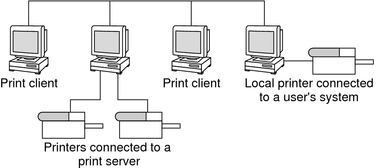| Skip Navigation Links | |
| Exit Print View | |

|
System Administration Guide: Printing Oracle Solaris 11 Express 11/10 |
| Skip Navigation Links | |
| Exit Print View | |

|
System Administration Guide: Printing Oracle Solaris 11 Express 11/10 |
1. Introduction to Printing in the Oracle Solaris Operating System
2. Planning for Printing (Tasks)
Planning for Printer Setup and Administration
Printer Configuration Resources
Printing Support in the Naming Service Switch
Adding Printer Information to a Naming Service
How the Printing Software Locates Printers
Assigning Print Servers and Print Clients
Print Server Requirements and Recommendations
3. Setting Up and Administering Printers by Using CUPS (Tasks)
4. Setting Up and Administering Printers by Using Print Manager for LP (Tasks)
5. Setting Up and Administering Printers by Using Oracle Solaris Print Manager (Tasks)
6. Setting Up Printers by Using LP Print Commands (Tasks)
7. Administering Printers by Using LP Print Commands (Tasks)
8. Customizing LP Printing Services and Printers (Tasks)
9. Administering the LP Print Scheduler and Managing Print Requests (Tasks)
10. Administering Printers on a Network (Tasks)
11. Administering Character Sets, Filters, Forms, and Fonts (Tasks)
12. Administering Printers by Using the PPD File Management Utility (Tasks)
13. Printing in the Oracle Solaris Operating System (Reference)
14. Troubleshooting Printing Problems in the Oracle Solaris OS (Tasks)
The goal of setting up printers on a network is to give users access to one or more printers. As an administrator, you must determine whether each printer would be best used if it is dedicated to one system or available to many systems. In a network environment, distribute your printers on several print servers. The advantage of setting up several print servers is that when one print server has a problem, you can route print requests to other print servers.
If you use a centralized print configuration, you can still connect printers to user systems for convenience or for improved response. A printer that is connected to a user system is still available to other systems on the network.
The following figure shows an example of how you can have a centralized print configuration and still connect printers to users' systems.
Figure 2-1 How to Distribute Printers on a Network
